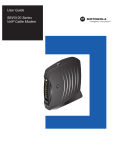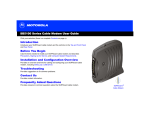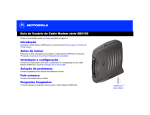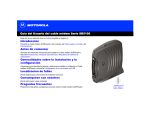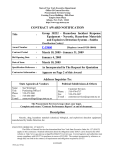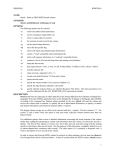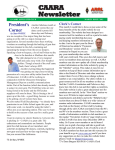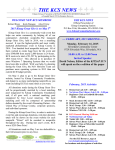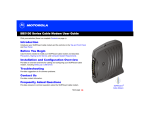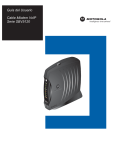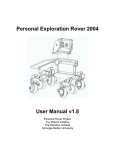Download User`s Guide - Wave Broadband
Transcript
Cable Phone Internet User’s Guide 1-866-WAVE-123 WaveBroadband.com Table of Contents Welcome ............................................................................................................................3 How to Contact Us/Payment Options.....................................................................4 Payment Locations..........................................................................................................5 Using Your Remote..........................................................................................................7 Programming Your Remote........................................................................................8 Cable Television Audio/Video Cables.................................................................................................9 Basic Cable............................................................................................................... 10 Installing Basic Cable Digital Cable.............................................................................................................11 High Definition TV................................................................................................. 14 Digital Video Recorder......................................................................................... 18 Installing Digital Receiver Digital Cable Troubleshooting Installing your HD/DVR Receiver HD Troubleshooting Installing your DVR DVR Troubleshooting High Speed Internet Your Cable Modem............................................................................................... 20 Installing Cable Modem Configuring Your Computer.............................................................................. 22 Wave Email............................................................................................................... 26 High Speed Internet Troubleshooting........................................................... 27 Getting Set Up Server Settings WavePhone™ Phone Equipment.................................................................................................. 28 Standby Button & Battery Backup................................................................... 30 MyWavePhone.com Portal................................................................................. 31 Voicemail.................................................................................................................. 32 Setting Up Changing Your Greeting, Name and PIN Calling Features...................................................................................................... 33 Troubleshooting.................................................................................................... 36 2 Welcome To Wave Broadband! Thank you for choosing Wave Broadband. Wave is your premier local provider of cable television, high speed internet, and phone services. No matter which package you select we hope you will be impressed with our service – from the breadth of our high definition selection and the speed of our internet access, to the savings of our all-inclusive phone service and the variety of our exclusive local programming. Wave prides itself on being number one in hassle-free maintenance, offering FREE in-home service calls and live 24x7 customer care. With Wave there’s no expensive equipment to buy or maintain, and no antennas or satellite dishes to worry about. This User’s Guide will help you install and get acquainted with your new service, and help you to reinstall your existing cable or internet connection should you get a new TV or computer. Questions? Contact us! With Wave Broadband you get prompt, courteous local service. It’s just another reason why we are the best choice in TV, internet and phone. Technical support is available 24 hours a day, 7 days a week. If you have questions, please call us at 1-866-WAVE-123, or visit our web site at WaveBroadband.com. In addition to the information in this guide, you can find lots of other useful resources on our website such as: • Channel Line-ups • TV Listings • Account Information • Billing Guide • Bill Payment • Email Support Services • Webmail • Personal Web Space • Technical Support • and More! 3 1-866-WAVE-123 WaveBroadband.com How to Contact Us: Billing & Sales Phone Hours: Monday to Friday 7:30am – 8pm Saturday 8am – 5pm Sunday 9am-1pm Technical Support Phone Hours: 24 hours a day, 7 days a week Mailing Address: Wave Broadband P.O. Box 34808 Seattle, WA 98124-1808 Payment Options: Pay Online You can view your account and make payments at our billing website: https://CableAnytime.net/Wave You will need to register your account and select a PIN the first time you access your account online. Pay by Check Separate the payment slip portion of your bill and mail it, along with your payment check, in the envelope provided with your bill. Make your check payable to “Wave Broadband” and write your account number on your check. Automatic Payment Program You can set up your account to automatically debit your credit card or checking account each month. Contact us at 1-866-WAVE-123 to complete the one-time set up. Online Banking or Bill Pay You can also pay your Wave Broadband bill through your financial institution’s or another third party’s bill payment program. Enter “Wave Broadband” as the payee and enter the payment address and account number as they appear on your bill. Paperless Billing Save paper and save time by getting your billing statement delivered electronically each month. Go to https://CableAnytime.net/Wave to sign up today! Pay in Person In addition to the methods mentioned above you may stop by one of our designated payment locations to pay your bill in person. Check for the location nearest you on the following pages. 4 Payment Locations: Washington Arlington/Lakewood Payments Only (Posting may take up to a week) 24-Hour Drop Box Lakewood Grocery 1507 172nd St. NE Arlington, WA 98223 Bangor Full Service Office Mon-Fri 8:30 am – 5:00 pm (Closed 12 – 1 pm) 24-Hour Drop Box Wave Broadband 2720 Ohio St. Silverdale, WA 98315 Belfair Full Service Office Mon-Fri 8:30 am – 5 pm (Closed 1 – 2 pm) Sat 9 am – 1 pm Wave Broadband 23910 NE State Highway 3 (in Chamber Building) Belfair, WA 98528 Burlington Payments Only (Posting may take up to a week) 24-Hour Drop Box Index Cable 1781 Old Hwy 99 N Rd. Burlington, WA 98233 Clear Lake Payments Only (Posting may take up to a week) Mon-Sun 7 am – 8 pm Clear Lake Market 12689 State Route 9 Clear Lake, WA 98235 La Conner Full Service Office Drive-Up Payment Drop Box Mon-Sat 8 am – 5 pm (Closed Sat 12:00– 1:00 pm) Wave Broadband 15 South Maple Avenue LaConner, WA 98257 Mt. Vernon Payments & Equipment Drop-off (Posting may take up to a week) Mon-Thurs 6 am – 9 pm Fri 6 am – 10 pm Sat-Sun 7 am – 8 pm Big Lake Grocery 16818 Lake View Blvd. Mt. Vernon, WA 98274 Port Angeles Full Service Office Mon-Fri 9 am – 5 pm 24-Hour Drop Box Wave Broadband 725 E. First Street Port Angeles, WA 98362 Port Orchard Full Service Office Mon-Fri 8:30 am – 5:30 pm Sat 9:00 am – 6:00 pm 24-Hour Drop Box Wave Broadband 4519 SE Mile Hill Drive Port Orchard, WA 98366 Sedro-Woolley Payments only (Posting may take up to a week) Mon-Thurs 6 am – 8 pm Fri 6 am – 8:30 pm Sat 7 am – 8:30 pm Sun 8 am – 8 pm Glen Haven Store 3094 Glenhaven Drive Sedro-Woolley, WA 98284 Sequim Full Service Office Mon-Saturday 8:30 am – 5:30 pm (Closed Sat 12:00 pm - 1:00 pm) Wave Broadband 153 S. Sunnyside Avenue Sequim, WA 98382 (Across from Post Office) Sequim Payments only (Posting may take up to a week) 24-Hour Drop Box Sequim City Hall 152 W Cedar St. Sequim, WA 98382 5 Payment Locations: Washington cont... Stayton Full Service Office Mon-Sat 9 am – 6 pm Full Service Office Mon, Wed-Fri: 8 am – 5 pm Tues: 9 am – 5 pm (closed daily 12:30 – 1:30 pm) Full Service Office Mon-Fri: 8 am – 6 pm Sat: 10 am – 4 pm 24-Hour Drop Box Stanwood Woodburn West Sacramento Full Service Office Mon-Sat 9 am – 6 pm (Closed 12 - 1 pm Sat) 24-Hour Drop Box Full Service Office Mon-Fri: 9 am- 6 pm Sat: 10 am- 2:30pm Full Service Office Mon-Fri: 8:00 am – 6:00 pm Sat: 10 am – 4 pm California Winters Wave Broadband 9853 Silverdale Way NW, Ste 102 Silverdale, WA 98383 (next to Papa John’s Pizza) Wave Broadband 9300 271st NW, Suite B-1 Stanwood, WA 98292 Oregon Canby Full Service Office Mon, Wed-Fri: 8 am – 5 pm Tues: 9:00 am – 5 pm (closed daily 12:30 – 1:30 pm) Wave Broadband 353 NW 2nd Street Canby, OR 97373 Sandy Full Service Office Mon-Fri: 9 am – 6pm Sat: 9 am – 7 pm Wave Broadband 36653 Hwy. 26 Sandy, OR 97055 Sheridan Full Service Office Mon, Wed-Fri: 8 am – 5 pm Tues: 9 am – 5 pm (closed daily 12:30 – 1:30 pm) 128 North Bridge Street Sheridan, OR 97378 Silverton Payments Only Mon-Fri: 9 am – 9 pm Sat: 9 am – 7 pm Sun: 9 am – 6 pm Hi-School Pharmacy 406 McClaine Street Silverton, OR 97381 6 Rocklin Silverdale Wave Broadband 277 3rd Avenue Stayton, OR 97383 Wave Broadband 669 Glatt Circle Woodburn, OR 97071 Auburn Full Service Office Mon-Wed, Fri: 8 am – 5 pm Thurs: 8 am to 6 pm 24-Hour Drop Box Wave Broadband 1015 LIncoln Way Auburn, CA 95602 Dixon Payments only Mon-Fri: 9:30 am – 6:30 pm; Sat: 9:30 am – 5:30 pm Hometown Market 925 N. Adams Street Dixon, CA 95620 Garberville Full Service Office Mon-Fri: 8:00 am – 5:00 pm (closed daily 1 pm– 2 pm) 24-Hour Drop Box Wave Broadband 615 Bear Creek Road Garberville, CA 95542 Lincoln Full Service Office Mon-Fri: 8 am – 5 pm 24-Hour Drop Box Wave Broadband 554 E Street Lincoln, CA 95648 Wave Broadband 4120 Citrus Ave Rocklin, CA 95677 Wave Broadband 1031 Triangle Court West Sacramento, CA 95605 Payments only Mon-Fri: 8 am – 7 pm Sat: 8 am – 6 pm Sun: 8 am – 5 pm Pacific Ace Hardware 35 Main Street Winters, CA 95694 Woodland Full Service Office Mon-Fri: 8:30 am – 5:30 pm Wave Broadband 1296 E. Gibson Road, Suite D Woodland, CA 95776 Using your remote control For additional settings and information, please visit WaveBroadband.com System On/Off Turns on/off two, three, four or all five devices with one button press. Menu Displays the i-Guide Menu. Guide Displays the program guide listings. Power Allows you to turn on and off your TV, VCR, DVD, AUX and CABLE box. AUX, DVD, VCR, TV, CBL Used to select the device you wish to operate and indicates remote control activity. Info Settings Displays the I-Guide Settings Menu. Displays information about the program currently playing or highlighted in the program guide. OK Page +/- Selects highlighted screen options. Help Opens Help. Vol , Accesses pages above or below the information currently displayed. Exit Exit from current screen. Raises or lowers the sound level. Day +/- Highlight an item from the on-screen choices. Skip forward or backward a whole day in the program guide. A, B, C Mute Ch Silences the audio. Press to activate. Press this key again to restore sound to the previous level. Fav Views favorite channels. Currently not in use. , Selects the next higher or lower channel. Last Accesses the previously tuned channel. Live Displays live television programming. Replays the previous few seconds of a program. List Displays a list of programs that you have recorded, allowing you to select one for viewing. PPV Direct access to Pay Per View. May be custom programmed (see page 8) VCR/DVD/VOD Keys Perform standard VCR and DVD functions when in VCR and DVD mode, and TV On Demand functions when in CABLE mode*. Number Pad Enter numbers to tune to channels. Also make numeric entries on on-screen menus. You can also use the Ch +/- and the guide as alternate ways to tune to channels. On/Off Aspect Input +/- Swap Move Opens or closes the PIP window. Selects the video source on your television. Switches a dual tuner DVR between the two tuners. On a television, switches the channels between the PIP and the main screen. Change the viewing aspect. Selects the next higher or lower channel in the PIP window. Moves the PIP window to another location on the screen. VOD Direct access to TV On Demand. May be custom programmed (see page 8)*. Note: Your remote may vary from the one shown here; however, the basic functions should remain the same. To see detailed diagrams of most Wave remotes, please visit WaveBroadband.com *Not available in all areas. 7 Programming your remote control For additional settings and information, please visit WaveBroadband.com Auto Search Method Your cable remote may be used to control other devices within your entertainment system. You can use the Auto Search Method to find the correct code number for your equipment by following the steps below: STEP 1 operate. Turn on the equipment you wish to STEP 2 Press the [DEVICE] button (TV, VCR, DVD or AUX) to be programmed and the [OK] button simultaneously for 3 seconds. The device LED will turn on. TIP: The device LED will turn on for 20 seconds. The next step must be entered while LED is on. STEP 3 Press the [CH+] or [CH-] button one at a time or keep it pressed. The remote will emit a series of power on/off commands. Release the [CH+] or [CH-] button as soon as the equipment turns off. TIP: You can verify that you selected the correct code by pressing the [POWER] button. The equipment should either turn on or off. STEP 4 Press the same [DEVICE] button to store the code. The device LED will blink twice to confirm that the code has been stored. It is possible to manually enter a code that directly corresponds to the brand of your device. Refer to the instruction manual that came with your remote, or to view the manual online, please visit WaveBroadband.com. Programming Volume Control By following the steps below, you can program the volume controls (Volume Up and Volume Down) from one device to operate in another device mode. The default volume control settings on the remote control are as follows: CBL: TVTV: TV DVD: TV AUX: AUX VCR: TV If you wish to store the CBL volume control in CBL mode, use the following steps. 8 STEP 1 Press the [CBL] button and the [OK] button simultaneously for 3 seconds. The [CBL] device LED will turn on. TIP: The device LED will turn on for 20 seconds. The next step must be entered while LED is on. STEP 2 Press the [VOL+] button. STEP 3 Press the [CBL] button. The device LED will blink twice to confirm the programming. To return to the original state: If you wish to restore the TV volume control in CBL mode, repeat the above steps by pressing [TV] in STEP 3. Programming for Advanced Function In the CBL mode, the VOD and PPV buttons can be programmed to act as a macro or favorite channel button. You can send up to ten commands with one button press. STEP 1 mode. Press the [CBL] button to select the CBL STEP 2 Press the [VOD or PPV] button and [OK] button simultaneously for 3 seconds. the [CBL] device LED will turn on for 20 seconds. STEP 3 Press up to 10 buttons you wish to store. The [CBL] device LED will blink once for each command entered. STEP 4 Press the [CH+] button to store the functions that were selected. The [CBL] device LED will blink twice to confirm storage of the functions. Low Battery Warning When the batteries are low and need to be replaced, the remote control LED will blink 2 times in sequence whenever a [POWER] button is pressed to turn on equipment. Audio/Video Cables Make the Best Connection! The cables you use to connect cable to your home entertainment equipment could be as simple as a single line to your television, or as complicated as a multiple component home theater. Your equipment will only work when using the right cables for the job, and you should know how you are hooking up your components. Check the connectors to see what cables you are using: Coaxial cable, or “coax,” is the standard cable line that is installed in your home. If you have basic or digital cable, this may be the only kind of cable you need. Composite RCA consists of three cables that deliver an analog output divided into red and white cables for stereo audio, and a yellow cable for video. They can be used to connect a Digital Cable Terminal (DCT) to a non-HDTV, a VCR or a stereo tuner. S-Video is a sharper alternative to the yellow RCA video cable, but still using the red and white RCA audio cables. It can be used to connect a DCT to a non-HDTV or a VCR. Component RCA consists of five cables that deliver the sharpest analog output, divided into red and white cables for stereo audio, and red, green and blue cables for video. They can be used to connect a DCT to a HDTV or a non-HDTV. HDMI (High Definition Multimedia Interface) is a single cable that delivers a digital audio and video output. It can be used to connect a HD DCT to a HDTV. (You may still wish to use separate audio connections for Surround Sound.) DVI (Digital Video Interface) is a single cable that delivers a digital output. It can be used to connect a HD DCT to a HDTV. Coaxial SPDIF (Sony/Philips Digital InterFace) is a single cable that delivers Dolby Digital 5.1 audio output. It can be used to connect a DCT to a stereo tuner. Optical SPDIF is a single cable that delivers the best available Dolby Digital 5.1 audio output. It can be used to connect a DCT to a stereo tuner. 9 Cable Television Basic Cable Wave Basic Cable is simple to install. You don’t need any additional devices, and you can connect to any cable-ready TV in your home – provided you have activated your Wave cable service. To connect to Wave cable, you simply run a coaxial cable from your wall mounted cable outlet to your cable-ready television set or to your VCR. If you find that your cable outlet is not activated, or you need additional cable outlets installed in your home, please contact us to schedule a professional installation. Installing Basic Cable • The connection from the outlet to your TV or VCR will always be coaxial cable. If you use a VCR, you can use a different cable from your VCR to your TV. • Check connections to ensure they are threaded correctly and firmly tighten by hand; do not use tools to tighten. • If you use a VCR, you will need to tune your TV to channel 3 or 4 to watch cable. Check the VCR user manual for more information. • Since your personal components may vary as well, please refer to your user manual(s) for installation of those components. • Some channels in Basic Cable may require additional equipment. Check your Channel Lineup card for more information on which channels require equipment. Digital Cable Wave Digital Cable gives you access to up to 300 channels of entertainment, as well as digital music, payper-view and interactive on-screen programming guide. Digital cable requires a digital cable terminal (DCT) installed in your home, or a CableCard installed into a television with a card slot. Not all DCTs look alike. The one you receive may vary slightly from the diagrams on the following pages. 10 Cable Television Installing Digital Cable Connect your digital cable terminal to your TV or VCR by referring to the following diagrams. After installation you may be receiving more channels than what you ordered. Within 24 hours, the DCT will automatically reset itself with your programming package. 1 2 3 4 5 DCT2000 Series CURSOR REMOTE MESSAGES A/ B GUIDE INFO 6 7 8 CHANNEL POWER MENU 9 SELECT 10 POWER A/B 11 12 13 1 Lights if optional A/B switch is activated (see #11). 2 Lights to indicate that a message is present. Refer to the “Using Your Interactive Programming Guide” for instructions on how to retrieve messages. 3 Normally displays current channel number or time of day; in the diagnostic mode, displays diagnostic codes. 4 Flashes when an error-free signal is received from the remote control. 5 Lights when the unit is on. 6 Displays the interactive programming guide (i-Guide). 7 Moves the cursor in menu and program guide screens. 8 Displays current channel and program information. 9 Displays the Main Menu. 10 Selects function options and Pay-Per-View (PPV) events and tunes channels from the i-Guide. 11 When enabled, this switches an add-on module from one function to another function. 12 Changes channel up and down. 13 Turns DCT on/off. 11 Cable Television 1 2 3 5 4 DCT2000 Series AUX AUD IO IN TO T V/VCR SPDIF TO RF IN S-V IDEO HIGH SPEED RF IN CAB LE IN R L AUD IO OU T V IDEO OUT OF BAND IR SWITCHED 105-125V 60Hz 4A MAX 500W MAX T V Pass Card DATA 6 8 7 1 Coaxial connector used to connect the DCT to a standard TV or VCR. 2 Coaxial connector used for DCT input from the TO RF IN connector. Deactivated on boxes without a pre-installed connecting cable. 3 Coaxial connector used to connect the TO RF IN port to the RF in port. Deactivated on boxes without a pre-installed connecting cable. 4 RCA jacks for looping through audio from auxiliary audio equipment. 5 S-Video connector used for high quality video to external devices such as high-end VCRs or TVs. 6 RCA jack used to connect the DCT to a composite (baseband) video TV or a monitor; in some configurations this jack connects to a VCR. 7 Optional connectors. Not active. 8 AC power outlet that can be configured as a switched or unswitched outlet and a two-pronged plug for attaching a power cord. Using Coaxial Cables Using Audio & Video Cable or Audio & S-Video Cables DCT2000 Series AUX AUD IO IN TO T V/VCR SPDIF TO RF IN S-V IDEO RF IN R L AUD IO OU T CAB LE IN V IDEO HIGH SPEED DATA Either or CABLE IN CABLE OUT R AUDIO IN L AUDIO R OUT L VIDEO IN SVIDEO IN VIDEO OUT SVIDEO OUT VCR (optional) Either or AUDIO IN R R TV 12 L AUDIO OUT CABLE IN L OUT OF BAND T V Pass Card VIDEO IN SVIDEO IN IR SWITCHED 105-125V 60Hz 4A MAX 500W MAX Cable Television Digital Cable Troubleshooting If you subscribe to Digital Cable you can connect any number of television sets in your home for service, but you will need an additional DCT or CableCard to receive digital channels for each television you connect. You do not need extra equipment to receive Basic Cable on additional television sets. Pay-Per-View, TV On Demand and i-Guide With Wave Digital Cable, you have access to the interactive programming guide, or i-Guide. Refer to the “Using Your Interactive Programming Guide” included in your welcome kit for instructions on how to use the features of the i-Guide. • If you have a VCR, be sure to connect it between the DCT and the TV. • Make sure to tune your TV or VCR to channel 3 and use the digital remote to watch cable. • If you have a TV with multiple inputs for coaxial, S-Video and RCA cables, make sure your TV is set to the correct input. • Refer to the “Using Your Interactive Programming Guide” included in your welcome kit for instructions on how to set your DCT volume to a comfortable mid-range level. • Your cable remote should be programmed to control your television, as well. If it is not, refer to the instructions on page 8 of this manual to program it. Once it is programmed successfully, control your TV volume using the cable remote. • If you have picture but no sound, check to see if the DCT volume has been reset, or if the TV is muted. • If you have no sound and are using a stereo tuner, check the cable connections and settings for the tuner. • If you are not receiving all of your channels, or if the on-screen i-Guide is showing “One Moment Please” for more than a few minutes, power-cycle the DCT by unplugging the power for one minute. Your programming package should reload within a few minutes, but the on-screen i-Guide and menu, or the PPV and TV On Demand programming, can each take up to one hour to reload. • If the DCT indicates it is downloading programming with “DL” displayed on the front panel, this process may take up to 30 minutes. If you power-cycle the DCT during this time, the download will start over. If the display shows “DL” for more than 30 minutes, you should call our technical support department. • If the DCT shows another error code on the front panel, please call our technical support department. • If you have a TV with a CableCard and you lose some of the programming, unplug the CableCard and power-cycle the TV by unplugging the power for one minute. Securely plug the CableCard back into the TV and then restore power to the set. 13 Cable Television High Definition Television High definition television (HDTV) combines extremely high resolution with Dolby Digital Surround Sound to provide a sharp viewing experience. Not all HD DCTs look the same. The one you receive may vary slightly from the diagram. Message Indicator A/B Indicator Lights when a message is waiting Lights, if optional switch is activated POWER switch SELECT switch Turns the DCT* on or off Selects menu options MENU switch GUIDE switch Displays the menu area Displays the program guide INFO switch A/B switch Displays current channel and program information Manually enables RF bypass function (optional) CH ANNEL CURSOR INFO A/B P MSGS. A/B MENU GUIDE ON SMART C ARD REMOTE MU TE POW ER USB VIDEO IN SELEC T L AUDIO IN R CURSOR Moves cursor around program guide and menu screens AUDIO IN (L/R) POWER indicator REMOTE indicator SMART CARD Lights to indicate DCT is on Lights to indicate remote control is in use Not active Not active USB Not active VIDEO IN Not active Display Displays channel number and time of day DCT 6400 Series CHANNEL Scrolls down or up through the channels Is my TV High Definition? You can examine your TV to determine what inputs are available to use. Some Enhanced Definition televisions (EDTV) will have inputs usually associated with HDTV service. To be certain whether your TV is HDTV, you will want to refer to the user’s manual. Installing High Definition Television High definition television (HDTV) can be viewed using component RCA, HDMI or DVI connections. Not all HD DCTs have the same connections, and will usually have either HDMI or DVI, not both. If you wish to use the HDMI or DVI connection on your HDTV, but your DCT does not have the appropriate connection, you can call our customer service department or stop by your local office to get a DCT with the connections you want. What kind of connection do I want? In most cases, component RCA, HDMI and DVI connections provide comparable quality pictures, and RCA cables can be easier to use. However, if your HDTV is 42” or larger, or capable of 1080p resolution, you will likely notice a superior picture from HDMI or DVI. Similarly, if you use the speakers on your HDTV, audio RCA connections will provide comparable sound quality to SPDIF cables. However, if you are using a stereo tuner with Surround Sound, you will receive superior audio quality by using a coaxial or optical SPDIF cable. 14 Cable Television Connecting to an HDTV using Component Video or DVI Connections – Video Only HDMI Operation Safety Before connecting or disconnecting any HDMI cable, all equipment must be powered off. Otherwise, it is possible to overload and damage the cable and/or the equipment. Connecting to an HDTV using Component Video or HDMI Connections – Video Only DCH6416 Series Either / or 15 Cable Television Connecting a DCT to your HDTV – Video First, connect the coaxial cable to the cable wall outlet and the CABLE IN connector on the DCT. For RCA Component Video (YPbPr): • Connect the component video cables to the Y (green), Pb (blue) and Pr (red) connectors on the back of the DCT and your HDTV. For DVI: • Connect the DVI cable to the DVI-D OUT connector on the DCT, and the DVI-HDTV connector on your HDTV. For HDMI (audio and video): • Connect the HDMI cable to the HDMI OUT connector on the DCT, and the HDMI IN connector on your HDTV. • If you are using a HDMI-capable receiver, connect one HDMI cable to the HDMI OUT connector on the DCT, and the HDMI IN connector on your receiver. Connect the second HDMI cable to the HDMI OUT on your receiver, and the HDMI IN connector on your HDTV. • The HDMI equipment must be turned on in order. First turn on the DCT, then turn on your HDMIcapable receiver if you have one, then turn on your HDTV. Connecting to an HDTV using optical, SPDIF, or RCA Connections – Audio Only DCH6416 Series L/R audio connection SPDIF optical connection (digital audio) SPDIF coaxial connection (digital audio) The HDMI connection also provides audio. No additional audio connections are required if the TV speakers are used for audio. 16 Cable Television Connecting a DCT to your HDTV – Audio Only For RCA Audio: • Connect the audio RCA cable to the right (red) and left (white) connectors on the back of the DCT and your HDTV. For coaxial or optical SPDIF: • Connect either the coaxial or the SPDIF cable to the connectors on the back of the DCT and your Surround Sound stereo tuner. High Definition Television Troubleshooting • If you do not have a picture on your HDTV, turn off all equipment and check your connections. Some connectors such as HDMI can slip loose of the equipment, in which case you’ll want all equipment off when reconnecting. • If the picture is not displaying correctly with a digital connection, you may need to switch to an analog connection to troubleshoot your settings. • The DCT output settings must match your HDTV input settings. To check the DCT output settings, turn the DCT off and hold down the Info and Guide buttons on the front panel at the same time. To check your HDTV input settings, check the manual or contact the support department for your HDTV manufacturer. • Many home theater systems use automatic switching, allowing you to connect multiple devices to the receiver, and connect a single cable from the receiver to the television. • If you use a receiver between the DCT and your HDTV and encounter any problems, try bypassing the receiver. Some receivers do not relay all digital copy protection signals, which prevents the picture from being displayed. • If you have no sound and are using a stereo tuner, check the connections to and settings for the tuner. • If you have no sound only on HD channels, your system may not be compatible with the multichannel audio formats available with HDMI and SPDIF. If this is the case, set the digital audio setting for your HDTV or stereo tuner to PCM. This will convert the digital signal to an analog form the equipment can use. • If any additional equipment in your home theater is not working correctly, you will want to refer to the user manual(s) for that equipment, or contact the support department for that equipment. The settings on audio/video equipment vary greatly from one manufacturer to another, and Wave Broadband technical support is not trained to troubleshoot third-party equipment. 17 Cable Television Digital Video Recorder Wave’s Digital Video Recorder (DVR) is installed in the same manner as a regular DCT, depending on the equipment in your home. Most Wave DVRs are capable of HD service. How you choose to have it connected to your TV or home theater will depend on what services you have from Wave and what your equipment will support. Not all DVR DCTs look the same, and as equipment continues to evolve the one you receive may look different from the one that’s pictured here; however, the diagram below should provide an adequate overview of the standard features found on most DVR DCT boxes. DCH6416 Series 1 USB 2.0 High-Speed Connector (Not active) 2 Cursor – menu navigation 3 Select – selects menu options 4 Power – turns the receiver on and off (standby) 5 Menu – displays the menu 6 Guide – displays the program guide 7 Info – displays current channel and program information 8 Format* – change the video output format 9 Channel – changes channel up or down * Availability of certain features is dependent upon application support. You may refer to the diagrams on page 14 and 15 of this User’s Guide for installation, or for additional diagrams and connection options, visit WaveBroadband.com. Once your DVR is connected, refer to the i-Guide quick reference guide included with your welcome kit for instructions on using the DVR menus. 18 Cable Television DCH6416 Series 1 Cable In – Connects to cable signal from your wall outlet 8 Video/Audio – Composite Video (SDTV)/ Audio inputs and outputs 2 RF Out – Ch 3/4 modulated audio/video (SDTV) to DVD players or VCRs 9 HDMI – High-Definition TV (HDTV) connector 3 M-Card – Inserted M-Card 10 eSATA* – External Serial ATA disk interface 4 Serial – Service only 11 Ethernet* – Network connection 5 S-Video – Connects to S-Video (SDTV) inputs of TV or VCR 12 USB* 2.0 – High-Speed peripheral device connection 6 Digital Audio (S/PDIF) – Provides Dolby® Digital 5.x audio or PCM output 13 IEEE-1394* – Audio and video device connection 7 YPbPr – Component video output (HDTV) 14 Power cord connector * Currently not active. Digital Video Recorder Troubleshooting DVR Operation Safety A DVR requires plenty of open space for ventilation. It is preferable to have at least 2” of clearance above the DVR, and 1” of clearance to the left and right sides of the DVR. Do not place the DVR in a closed cabinet. • If the fan in the DVR is making an excessive amount of noise, check the ventilation and feel how much heat is being generated around it. The DVR may need to be placed in a different position that allows more air flow. • The troubleshooting tips for Digital Cable (p. 13) and HDTV (p. 17) also apply to possible issues with a DVR. However, if it is necessary to power-cycle the equipment, you will want to leave the DVR unplugged for two minutes, or until it is no longer warm to the touch. • After a power-cycle of the DVR, it may take up to one hour for the menu features to be restored. However, the LIST button on the remote should work to access recorded programs, once TV reception has returned. • Many DVRs are manufactured with data connections, such as USB, ethernet, IEEE 1394 (firewire) and SATA, for future functionality. These connections are not active at this time. 19 High Speed Internet This guide will help you become acquainted with Wave’s internet service and provide step-by-step instructions on how to install your cable modem. It also provides instructions on how to create your wavecable.com email account, and configure it to work with email software on your computer. Any standard cable modem will work with Wave service. These instructions reference the Motorola Surfboard modem, but can be used with any model. If you have specific questions about your model of cable modem, please check the user’s manual, many of which are available on WaveBroadband.com. Your Cable Modem First, connect the coaxial cable to the wall outlet or cable splitter, and to the CABLE port on the modem. Thread and tighten the connections by hand; do not use tools to tighten. Then attach the power cord to the cable modem and plug the cord into an electrical outlet. Check the modem lights to verify it is able to connect to the internet. 1 2 3 WE R E CEIV E R PO 4 SEND D T AN B Y S TY PC ON LIN E /ACTIVI SB5100 SURF b oard® Ca b le Mo de m 5 6 7 1Standby Press to suspend your Internet connection. No data is transmitted or received when the Standby light is on. All other front panel lights turn off until you press the Standby button again. 2Power Flashing: Startup diagnostics in progress On: The cable modem is powered on. Flashing: Scanning for a receive (downstream) channel 3Receive connection On: The downstream channel is connected Flashing: Scanning for a send (upstream) channel 4Send connection On: The upstream channel is connected 5Online Flashing: Scanning for a network connection On: The startup process is complete 6PC/Activity Flashing: Transmitting or receiving data On: A device, such as a computer or hub, is connected to the USB or Ethernet connectors on the back panel 7Standby This light does not flash On: Internet service is blocked because the Standby button was pressed. If this light is on, all other lights are off. During normal operation, the Power, Receive, Send, and Online lights are on and the PC/Activity light flashes when the cable modem is transferring data. 20 High Speed Internet Most cable modems other than the Motorola Surfboard indicate online status with a single cable light. If the cable light is flashing, the modem is acquiring a connection to the internet; if it is solid, the modem is online. If the modem is not able to connect to the internet, then the cable wall outlet may need to be adjusted. Please call our support department to schedule a time when a Wave technician can perform this work. If you are using a cable splitter to connect both the modem and your TV, it will affect the signal received by the modem. You can bypass the splitter and connect the modem directly to the wall outlet, to see if the modem can connect to the internet without using the splitter. Once the modem is connected to the internet, connect the cable modem to your computer using either an Ethernet cable, or USB cable. Ethernet or USB? Your computer may have a NIC, also called an Ethernet card. The NIC can be found in the back of your computer with a port that looks similar to a telephone jack, but somewhat larger. Alternatively, most computers have one or more USB ports built in. This is a small rectangular port on the front or rear panel of the case, and will be labeled USB. ETHERNE T USB 1 2 C AB LE 3 CUSTOMER S/N:BCDFGHJKLMNP HFC MAC ID: ABCDEF012345 S/ N: PPPPMMYJJJSSSSSCAABBCCCC USB CPE MAC ID: ABDCEF0123 45 +12VDC 4 NIC Port USB Port 1Ethernet The Ethernet port provides a connection to Ethernet equipped computers using a cable terminated with an RJ-45 connector. 2USB The USB port provides a connection to USB equipped computers. 3Cable The Cable port provides a connection to the coaxial cable (coax) outlet. 4+12VDC This connector provides power to the cable modem. 21 High Speed Internet Configuring Your Computer Once the cable modem is online and connected to your computer, it is necessary to set up your computer to access the internet through the modem. If you do not have a NIC and are connecting with USB, it is necessary to first install the USB drivers from the CD-ROM. If you are using Windows 98 SE or Windows ME, you may also need your Windows operating system software CD. Important If your computer has a NIC, you do not need to install software and you will have better computer performance by using Ethernet. Skip this section and follow the instructions for your operating system. Installing USB Software – Windows PC If you connect the modem to your computer with a USB cable and Windows does not automatically open the Add New Hardware Wizard, the USB port may be inactive or disabled. You can try another USB port, or use the Device Manager to enable the USB port, if it is disabled. To open the Device Manager, right-click on “My Computer” and select “Properties”, and go to the “Hardware” or “Device Manager” tab. Once the Add New Hardware Wizard is open, follow the on-screen instructions to install the USB driver software. When the wizard asks what to do, select “Search for the best driver for your device.” and click “Next”. On the following screen, select “Specify a location:” and choose your CD-ROM drive; click “Next”. Windows will find an updated driver from the selected location, and will install that driver by default; click the “Next” button on each screen until installation begins. Once loading the driver, Windows may ask you to insert your Windows CD to add certain cabinet files, or “cabs”. If you do not have your Windows CD, you can see if these files are already present on your computer; click “OK” on the Insert Disk dialog box and you will be prompted to enter a location to copy files from. Enter the path C:\Windows\Options\Cabs Click “OK” and wait for Windows to finish installing software. Then click “Finish” and restart your computer. If you encounter an error installing cabinet files, contact your computer manufacturer for support. 22 High Speed Internet Configuring Windows 98 SE / Windows ME • Click the “Start” button, move the mouse over “Settings” and select “Control Panel”. • Double-click the “Network” icon. • In the Network options, make sure you are on the “Configuration” tab. • In the list of network components, select “TCP/IP ->” for your model of NIC or cable modem. • Click the “Properties” button. • Select “Obtain an IP address automatically” and “Obtain DNS server address automatically”. • Click the “OK” button. • Close the Network options by clicking the “OK” button Configuring Windows 2000 • Click the “Start” button and select “Control Panel”. • Double-click the “Network and Dial-Up Connections” icon. • Double-click “Local Area Connection”. • Select either “USB” or “Ethernet Adapter” (NIC), as appropriate. • Double-click on “Internet Protocol”. • On the Properties screen, select “Obtain an IP address automatically” and “Obtain DNS server address automatically”. • Click the “OK” button. • Close the “Local Area Connection” window by clicking the “OK” button. • Close the “Network and Dial-Up Connections” control panel. 23 High Speed Internet Configuring Windows XP • Click the “Start” button and select “Control Panel”. • If the Control Panel says “Pick a category” click “Switch to Classic View”. • Double-click “Network Connections” • Right-click “Local Area Connection”, select “Properties” and make sure you are on the “General” tab. • In the list of “This connection uses the following items:” select “Internet Protocol (TCP/IP)” and click the “Properties” button. • Select “Obtain an IP address automatically” and “Obtain DNS server address automatically”, then click the “OK” button. • Close the “Local Area Connection Properties” by clicking the “OK” button. Configuring Windows Vista 24 • Click the “Start” button and select “Control Panel”. • Double-click “Network and Sharing Center”. • Next to “Local Area Connection”, click “View Status”. • In “Local Area Connection Status” click the “Properties” button. • In the list of network components, select “Internet Protocol Version 4 (TCP/Ipv4)” and click the “Properties” button. • Select “Obtain an IP address automatically” and “Obtain DNS server address automatically”. • Click the “OK” button. • Click the “Close” button on Local Area Connection Properties. • Click the “Close” button on Local Area Connection Status. High Speed Internet Configuring Mac OS 8.5 – 9.2 • Click on the Apple menu, move the mouse over “Control Panel”, and select “TCP/IP” • On the TCP/IP control panel, click on the “Connect via:” menu and select “Ethernet”. • Click on the “Configure:” menu and select “Using DHCP Server”. • Click on the “File” menu and select “Quit”. • On the warning dialog box that asks, “Save the changes to the current configuration?” click the “Save” button. Configuring Mac OSX, 10.1.5 or later • Click on the System Preferences icon in the System Dock, or click on the Apple menu and select “System Preferences”. • In the System Preferences window, click on the “Network” icon. • In the Network Preferences window, click on the “Locations” menu and select “Automatic”. • Click on the “Show” menu and select “Built-in Ethernet”. • Click on the “Configure” menu and select “Using DHCP”. • Make sure all other fields are black and click the “Apply Now” button. • Close the Network Preferences window. 25 High Speed Internet Wave Email While you can use any email provider you choose with Wave High Speed Internet, up to ten wavecable. com email addresses are included with your service. Each email address can store up to 30 MB of messages on Wave’s mail server. You can create an email address by going to www.wavebroadband. com, click on the “Support” menu and then select “Request Email Address”. Alternately, you can call our technical support department, and our staff can create one or more email addresses for you, and help you configure your computer. Once your email address is created, you can configure email client software on your computer to access it, such as Windows Mail, Outlook Express or Mac Mail. Any email software you use will need the following information to send and receive email for your wavecable.com address: Display Name: Your full name as you want it to appear in emails Email Address: Your email address, eg. [email protected] Incoming Mail Server: mail.wavecable.com Outgoing Mail Server: mail.wavecable.com Account Name: The first part of your address, eg. johndoe Password: The password you used when creating the address For complete instructions on how to set up the most common email client programs, visit www.wavebroadband.com, click on the “Support” menu and select “Email Setup”. Using Another Email Provider If you wish to use another email service rather than the email that comes free with your Wave internet, you will need to use the account settings for incoming mail from that provider. However, you will need to use mail.wavecable.com as your outgoing mail server – all other settings should be provided by your email service provider. Webmail Any time you are away from home and wish to check for new mail, or if you have not set up an email client program on your computer, you also have the option of accessing your email through our Webmail program. Webmail is available by going to www.wavebroadband.com, selecting “Webmail”. Alternately, you can access Webmail directly at http://webmail.wavecable.com/ When you login, your Login Name is the first part of your email address, eg. if your email address is [email protected], your Login Name is johndoe. If you are connecting from a computer using some form of security, you may need to select one or both of the check-mark boxes below the Login Name and Password. 26 High Speed Internet High Speed Internet Troubleshooting If you are unable to connect to the internet, first check your cable modem to see if it is online (see diagram, p. 20). If it is not online, power-cycle the modem by unplugging the power for 30 seconds. If the modem cannot establish the connection to the internet within a few minutes after the power-cycle, please call our technical support department for more help. If you are using a cable splitter to connect both the modem and your TV, you can bypass the splitter and connect the modem directly to the wall outlet to see if the modem can connect to the internet without using the splitter. If you have created a network in your home using a router, you will want to power-cycle both pieces of equipment: 1. Unplug power to both the modem and the router. 2. After 30 seconds without power, restore power to the modem. 3. Once the modem is online, restore power to the router. 4. Once the lights on the router indicate a connection, repair the internet connection on each computer. This may require restarting the computer. If the cable modem indicates a connection to the internet, but your computer cannot connect through a router, you will need to bypass the router and plug one computer directly into the modem: 1. Unplug the power to both the modem and the router. 2. Use a single Ethernet cable to connect the modem and one computer. 3. After 30 seconds without power, restore power to the modem. 4. Once the modem is online, repair the internet connection on the computer. This may require restarting the computer. If you are able to connect to the internet using a computer plugged directly into the modem, but cannot connect using your router, then your Wave internet service is working. You will want to contact the support department for the manufacturer of your router. If you received the router from Wave Broadband as part of our Wireless Home Networking service, please contact our technical support department for problems connecting with the router. If you are able to connect to the internet, but have another issue with your internet service, please check our website for a number of troubleshooting guides and tips. Go to WaveBroadband.com, and select “Support”. Internet Security Any time your computer is connected to the internet, no matter what kind of connection is being used – through cable modem, DSL or dial-up – there is some risk of your privacy being compromised. There are a number of things you can do to minimize your risk, such as installing firewall and virus protection software. You can also turn off “file sharing” and “network sharing” settings on your computer. 27 WavePhone™ WavePhone™ works just like other business phone services you may be used to, though it does require some equipment that you may not be familiar with. A Wave Technician will connect a small device called a Multimedia Terminal Adaptor (MTA) between your cable line and the existing phone jacks in your home to enable the service. If you have high-speed internet service from Wave, the MTA may also act as your internet cable modem Phone Equipment Note: Not all Multimedia Terminal Adapters (MTAs) look alike. The one you receive may vary slightly from the diagram below. 1. Power Light: indicates whether AC power is available to the unit 1 2 3 4 5 6 7 8 2. DS (Downstream): indicates downstream connectivity 3. US (Upstream): indicates upstream connectivity 4.Online: indicates internet data transmission status 5.Link: indicates Ethernet or USB connectivity between the MTA and computer 6. Telephone Line 1: indicates status of line 1 7. Telephone Line 2: indicates status of line 2 8.Battery: indicates status of the battery in the MTA Operation Safety Connecting the Telephony Modem (MTA) to your existing telephone wiring should be performed by a professional installer. Failure to do so may result in electrical shock, loss of phone service, loss of 911/E911 service and/or permanent damage to the Telephony Modem. 28 ( ( Power Outlet Phone 1 Phone 2 Computer USB (choice of either connection) Computer Ethernet Standby Button on the front of the MTA (It terminates the USB/Ethernet connection.) Cable Wall Outlet Reset Button The WavePhone™ Telephony Modem can be connected to your computer to work as an internet modem as well as a phone. While the MTA has two lines, the second line is only active if you have purchased an additional line from Wave Broadband. If problems exist with your phone service, connecting a phone directly into the back of the MTA will bypass your existing wiring and help determine if the issue exists with the service or the wiring at your location. 29 WavePhone™ During a power outage your modem may lose power if it is not equipped with a battery backup or the battery has been drained. This may require you to be temporarily disconnected until a power cycle is performed. If your modem disconnects, you will not be able to use the phone until service is restored or a power cycle is performed. See the Troubleshooting section on page 36 for more troubleshooting steps. Standby Button Some MTAs have a Standby button on the front of the unit. Pressing the Standby button will either suspend or activate your computers connection to the Internet. • Online Mode – Modem is online indicated by an illuminated Online light on the Telephony Modem. • Standby Mode – Modem is offline and in standby indicated by a blinking Online light. The Standby button does not affect telephone service; telephony service will work regardless of the status of your computer’s connection to the internet. Battery Backup Not all Telephony Modems (MTAs) have a battery backup. If your MTA does not have a battery light on the front then you do not have a battery backup. The battery backup will allow your phone service to continue to work for a short period of time should you lose power. However, if Wave’s network facilities are without power due to a local outage, cable service will not work, including your WavePhone™ service. Reset Button Using a paper clip to push the Reset button on the back of the Telephony Modem will reset the modem. • Straighten a paper clip and press into the reset hole in the back of the MTA. • Hold down this button until the lights on the front of the MTA turn off and then release. 911/E911 Emergency Information If you attempt to install or use the Wave Broadband equipment or VoIP services at another location, the VoIP services, including but not limited to 911/E911, may fail to function or may function improperly. WavePhone™ service is electrically powered and that service, including the ability to access 911 services, security and medical monitoring services, may not operate in the event of an area power outage or if the cable connection is disrupted or not operating. Included with your equipment are advisory warning stickers that provide information regarding the limitations of 911/E911 service with VoIP services. Please place these stickers on or near the equipment used with WavePhone™ services. 30 WavePhone™ MyWavePhone.com Portal • Check voice mail messages online at http://www.mywavephone.com. • Set up your voicemail preferences. • Manage your WavePhone™ features such as voicemail/call forwarding, call screening and contact list. • Get e-mail alerts when you receive voicemails. • Detailed instructions for using the WavePhone™ Portal can be found at http://www.wavebroadband.com/mywavephone Go to: http://www.mywavephone.com Use your voicemail PIN to log into the Phone Portal. Setting Up Your Voice Mailbox • To set up your voice mailbox for the first time you must dial (*9) or your telephone number from your home phone. • You will be prompted to create a PIN of four to twenty digits. • Record a name announcement. • Record a personal greeting or select one of the standard greeting options. • Prompts will allow you to correct and re-record announcements in case you are not satisfied with what you have recorded. Accessing Your Voice Mail • From home, dial (*9) or your telephone number • Away from home, dial your telephone number and press (*) during the greeting • Online, go to http://www.mywavephone.com 31 WavePhone™ Voice Mail Features • Incoming calls will be forwarded to voicemail after 24 seconds /4 rings by default. You can change this setting at MyWavePhone.com • Each message is time and date stamped • Messages can be up to 2 minutes in length • You can store up to 30 messages or 60 minutes worth of messages • Messages can be saved for up to 30 days. To save messages, press (2) • To fast-forward 5 seconds during message playback, press (99) • To rewind 5 seconds during message playback, press (77) • Press (#) to keep the current message and skip to the next message • To delete a message, press (3) • To reply to a message, press (4) • Press (0) for helpful hints Changing Your Greeting, Name and PIN • Access your voice mail by dialing (* 9) or your phone number, followed by your PIN • Press (3) to change your greeting and follow the prompts • To change your name, press (3) for the greetings menu, then press (3) to change your name and follow the prompts • To change your PIN, press (4) for mailbox settings, then press (3) for security options and follow the prompts Message Indicator If you have a new voice mail, you will notice a “staggered” dial tone when you pick up the line. This will continue until you have called and checked your voice mail. 32 WavePhone™ Calling Features The following features are included with Unlimited Phone or can be added to our other phone plans for an additional monthly charge. • Call Waiting – A tone will announce an incoming call when you are already on the phone. This feature comes automatically activated when included with or added to your Wave Phone service. Cancel Call Waiting (*70) – Turn off call waiting on a per call basis. Enter the code before making the call. • Caller ID & Call Waiting Caller ID – View caller information for incoming calls. These features come automatically activated when included with or added to your WavePhone™ service. • Caller ID Block (*67) – Block your Caller ID information from displaying on outbound calls on a per call basis. Enter the code before making the call. • Disable Caller ID Privacy (*82) – Turn off Caller ID Privacy on a per call basis. Enter the code before making the call. Note: This feature is used if you have Caller ID Privacy set as a permanent feature on your WavePhone™. You will receive a message when calling an individual who does not accept anonymous calls. Simply hang up, dial *82 and try again. • Repeat Dial (*66) – If you receive a busy signal when making a call, you can hang up, pick up the receiver again and enter the code. The system will continue to call the last number you dialed for up to 30 minutes. Once that line is free, your phone will ring with a distinctive ring. You may continue to make and receive phone calls as normal while this feature is activated. • Cancel Repeat Dial (*86) – Disable repeat dial before the 30 minute time frame is over. • Return Call (*69) – Return the call of the last person who called you. Like Repeat Dial, if the line is busy it will continue to redial the number for up to 30 minutes. Note: If the caller is calling you from a cellular phone, this feature will tell you the number of the last caller but you will receive a busy signal if you attempt to dial them back through the Return Call menu. Simply hang up and dial the number directly. Cancel Return Dial (*86) – Disable return call before the 30 minute time frame is over. 33 WavePhone™ • Call Forward (*72) – Forward incoming calls to another telephone number. If you forward calls to a long distance number, long distance charges may apply depending on your Wave Phone package. To activate Call Forwarding, press *72, wait for the confirming beeps, and then enter the phone number you would like calls forwarded to. You will immediately get a courtesy call at the phone number where calls will be forwarded. Answer the courtesy call to activate Call Forwarding. If you cannot answer the courtesy call, you must dial *72 again from your WavePhone™ and wait for the confirmation tone. Cancel Call Forward (*73) – Disables current call forwarding. • Selective Call Forwarding (*63) – Forward calls from a list of up to 12 people to another phone line. All other calls will ring through normally. Enter code again to edit or cancel Selective Call Forwarding. Simply listen to the helpful prompts that will walk you through setting up, adding and removing numbers or turning off this feature. Note: Selective Call Forwarding and Call Forwarding can be available on the same line, but only one can be active at a time. • Selective Call Rejection (*60) – Screen calls from up to 12 numbers that you specify. Enter code again to edit or cancel Selective Call Rejection. Simply listen to the helpful prompts that will walk you through setting up, adding and removing numbers or turning off this feature. • Selective Call Acceptance (*64) – Accept calls only from phone numbers that you specify. Simply listen to the helpful prompts that will walk you through setting up, adding and removing numbers or turning off this feature. • Anonymous Call Rejection (*77) – Automatically block numbers that have disabled their Caller ID information. They will hear a message that you are not receiving anonymous calls with instructions on how to disable their Caller ID privacy. Cancel Anonymous Call Rejection (*87) – Disables anonymous call rejection. • Distinctive Alert (*61) – Assign up to 12 phone numbers a distinctive ring. To set up this feature, dial *61, then follow the helpful prompts to add or remove numbers. • Speed Dial (*74) – Store up to eight unique numbers for convenience and speed. It is as easy as pressing a one-digit number followed by the # key. Adding a new number on speed dial automatically replaces the previously saved number. 1. Pick up the line and listen for the dial tone. 2. Dial *74 and listen for a second dial tone 3. Enter a one-digit code from two to nine, followed by the local or long-distance number you want to store exactly how you would need to dial it to make the call and then press the # button to store it 4. Listen for two beeps or a recording to confirm the number is stored and hang up. Note: To remove a speed dial number entirely, simply dial *74, enter the one-digit code you wish to remove and then press # again. 34 WavePhone™ • Two-Digit Speed Dial (*75) - Store up to thirty unique numbers for convenience and speed. Similar to Speed Dial, it is as easy as pressing a two-digit number followed by the # key. Adding a new number on two-digit speed dial automatically replaces the previously saved number. 1. Pick up the line and listen for the dial tone. 2. Dial *75 and listen for a second dial tone 3. Enter a two-digit code from twenty to forty nine, followed by the local or long-distance number you want to store exactly how you would need to dial it to make the call and then press the # button to store it 4. Listen for two beeps or a recording to confirm the number is stored and hang up. Note: To remove a speed dial number entirely, simply dial *75, enter the two-digit code you wish to remove and then press # again. • Three Way Calling – Bridge together two lines in addition to your own so that three separate individuals can speak on a single call. 1. While on a call with one of the individuals you wish to conference with, press the receiver button for one second. You will get a dial tone and the other caller will be put on hold. 2. Dial the number of the third party. When you get an answer, press the receiver button briefly again and all three parties will be connected. If the third party does not answer the phone, press the receiver button two times to cancel. You will still be connected to the first call. 3. When either of the people you called hangs up, you remain connected to the other person. When you hang up, everyone is disconnected. Note: Some phones have a “flash” or “link” button. Use this instead of the receiver button to change lines. While using three-way calling, call waiting is unavailable. 35 WavePhone™ Troubleshooting Tips • Power-cycling a Telephony Modem will often resolve most phone issues. If your Telephony Modem has a battery backup, please remove it before attempting a power cycle. 1. Unplug the power from the MTA for one full minute. 2. Plug the power back into the MTA and wait for all the lights to become solid. 3. Pick up your hand set and check for dial-tone Note: It can take up to 5 minutes for phone service to restore after a power cycle. • If the Online light is blinking on your modem, press the standby button to take your MTA out of standby mode. • If the Downstream (DS) or Upstream (US) lights are blinking, see the internet troubleshooting steps located on page 27. • Unplug the phone line from Line 1 in the back of the MTA and set aside. Plug a non-cordless phone directly into the MTA and test for dial-tone. If there is a dial-tone, plug each of your phones in one at a time to try and find the piece of equipment causing the problem. • Some equipment such as fax machines, certain cordless phones and caller ID units were designed before digital phone service was available. Please check with the manufacturer to determine if your equipment can be used with a digital phone line. • Voice Mail can interfere with a fax machine by taking the calls and/or confusing a fax machine into thinking there is no dial tone. Plug a phone directly into the line and listen for a staggered dial tone. If a staggered dial tone exists you must first check the voice mail on that line and then call Customer Service to have the voice mail feature removed. Call Data Records If you are having technical difficulties with an existing feature of your WavePhone™ service, it is very helpful to have a call data record ready before calling technical support. Simply write down the date, time and phone number or feature you are attempting to dial as an example to give to our technical support representative. This information will allow us to investigate the error more quickly. 36 The official Wave Broadband local franchise authority names and addresses are below. Please do not mail payments to your local franchise authority. Washington City of Bremerton 239 4th St., Bremerton, WA 98377 FCC Community Unit: WA 0229 Whatcom County 311 Grand Ave, Bellingham, WA 98225 FCC Community Unit: WA 0540; WA 0474 County of Clallam – Courthouse 223 E. 4th St., Port Angeles, WA 98362 FCC Community Unit: WA-0177; WA-0257 City of Port Angeles City Clerk, P.O. Box 1150 Port Angeles, WA 98362 FCC Community Unit: WA-0134 Island County – Engineer PO Box 5000, Coupeville, WA 98239 FCC Community Unit: WA 0274 Subase Bangor 1100 Hunley Rd. Silverdale, WA 98383 Naval Station Bremerton PSNS - BLDG 943-3 120 S. Dewey St. Bremerton, WA 98314 Kitsap County – Telecommunications Dept. 614 Division St, Port Orchard, WA 98366 FCC Community Unit: WA 0249; WA 0311; WA 0313; WA 0321; WA 0491; WA 0492 Town of La Conner PO Box 400, La Conner, WA 98257 FCC Community Unit: WA 0324 Mason County 411 N. 5th St., Shelton, WA 98584 FCC Community Unit: WA 0332; WA 0335 City of Sequim 152 W. Cedar, Sequim, WA 98382 FCC Community Unit: WA-0135 Skagit County - Treasurer PO Box 1306, Mount Vernon, WA 98273 FCC Community Unit: WA 0412 County of Snohomish 6th Floor County Admin Bldg. Everett, WA 98201 FCC Community Unit: WA 0468; WA 0336 City of Port Orchard 214 Prospect St., Port Orchard, WA 98366 FCC Community Unit: WA 0167; WA 0168 California City of West Sacramento Administrative Dept. PO Box 966 West Sacramento, CA 95691 City of Winters 318 First St. Winters, CA 95691 City of Woodland City Hall 300 First St. Woodland, WA 95695 City of Dixon 600 E. A St. Dixon, CA 95620-3619 Summerset at Rio Vista Braddock & Logam Group 4155 Blackhawk Plaza Danville, CA 94506 City of Rio Vista PO Box 745 Rio Vista, CA 94571 City of Stanwood 10220 270th St NW, Stanwood, WA 98292 FCC Community Unit: WA0289 Swinomish Tribal Community PO Box 817, La Conner, WA 98257 FCC Community Unit: WA0440 37 California cont. Humboldt County 825 5th Street Room 111 Eureka, CA 95501 City of Lincoln 640 5th Street Lincoln, CA 95648 Placer County 2986 Richardson Dr. Auburn, CA 95603 Lakeside Village Mobile Home Park - Park Mgr. 410 Danielle Way Folsom, CA 95630 Town of Loomis 6140 Horseshoe Bar Road, Suite K Loomis, CA 95650 City of Colfax 33 South Main Street Colfax, CA 95713 Pinebrook Village 214 Prospect St. Folsom, CA 95630 Oregon City of Mill City 252 SW Cedar Street Mill City, OR 97360 Clackamas County 2051 Kaen Street Oregon City, OR 97045 City of Sandy 39250 Pioneer Boulevard Sandy, OR 97055 City of Mount Angel 5 N. Garfield St. Mt. Angel, OR 97362 City of Silverton 306 S. Water Street Silverton, OR 97381 38 City of Aumsville 595 Main Street Aumsville, OR 97325 City of Turner 7250 Third Street Turner, OR 97392 City of Aurora 21420 Main Street Aurora, OR 97002 Clackamas County 2051 Kaen Road Oregon City, OR 97045 City of Barlow 106 N. Main Street Barlow, OR 97013 Marion County 555 Court Street NE Salem, OR 97301 City of Canby 182 N. Holly Street Canby, OR 97013 City of Donald 10790 Main Street NE Donald, OR 97020 City of Gates 101 Sorbin Avenue Gates, OR 97346 City of Gervais 524 Fourth Street Gervais, OR 97026 City of Hubbard 3720 Second Street Hubbard, OR 97032 City of Lyons 449 5th Street Lyons, OR 97358 City of Molalla 117 S. Molalla Avenue Molalla, OR 97038 City of Sheridan 120 SW Mill Street Sheridan, OR 97378 City of Stayton 362 North 3rd Avenue Stayton, OR 97383 City of Sublimity 245 NW Johnson Street Sublimity, OR 97385 39 0510 1-866-WAVE-123 WaveBroadband.com ©2010 WaveDivision Holdings, LLC










































